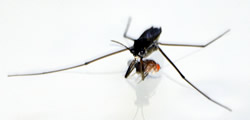Water Strider (Gerris buenoi)
 Water strider Image source: |
Contact: Abderrahman Khila and David Armisen
Researchers involved: Hemipteran consortium
Size (or size of nearest relative): ~500MB
Sequencing resources available: ~80X coverage 100bp paired end Illumina data
Keywords (and why important): Ecology and evolution, Developmental genetics, Integrative biology, sexual conflict, adaptive radiation
The water strider Gerris buenoi (Heteroptera, Gerromorpha) is a semi-aquatic insect readily observable in ponds rowing through the water surface. Several aspects of water striders’ biology argue in favor of genome sequencing in a representative of this group.
Wide scientific interest: water striders are model systems for ecology and evolutionary biology, population genetics, phylogenetics, and biomechanics. These studies have extensively contributed to our understanding of the forces that shape the evolution of adaptive traits in this group, including adaptations to locomotion on water surface, co-evolution of the sexes, mating systems and mating strategies, and wing polymorphism.
Rich morphological diversity: Water striders belong to the Gerromorpha, a group containing over 1900 described species, classified in eight families, whose evolutionary history has been estimated from the fossil record to 120 million years of geological time. This diversity offers a powerful model for identifying the genes and the genetic changes responsible for phenotypic variation within species, between populations, and across species.
Technical tractability: Semi-aquatic bugs are widespread and can easily be cultured in lab conditions. Importantly, we have shown that RNAi induced gene silencing is highly successful, and can be routinely employed for gene function analyses across semi-aquatic insects.
Potential medical interest: Water striders are predatory insects that can feed on mosquito larvae, and therefore constitute a potential natural enemy that can help keep mosquito populations at low levels. In addition, Gerris are known to host Mycobacterium ulcerans; a virulent bacterium that causes severe necrotizing cutaneous infections.
Genomic Resources
For the most current version of the assembly, please use 'NCBI BioProject' (find link below). If the assembly is unavailable in the BioProject page (it is still being worked on), you can look under the 'BCM-HGSC data' (find link below) for intermediate versions of the assembly.
Web Apollo: A web-based sequence annotation editor for community annotation
For information about Web Apollo, please contact Monica Poelchau.
-
Web Apollo annotation tool (requires log in)
-
Web Apollo Jbrowse viewing of the automated annotation tracks (no log in required)